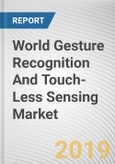With these technologies, user tasks are performed by machines by analyzing their actions. It enhances user’s experience at the same time improves quality of service. Hence, such solutions are becoming increasingly popular in healthcare, hospitality, consumer electronics and retail industries. The research presents competitive benefits achieved with these technologies and accordingly market overview is depicted.
The market is driven by need of sophisticated automatic processes in industries such as government, BFSI, etc. There are other factors driving the market such as increasing concern about hygiene and user experience. The market faces limitations due to higher switchover cost, lack of awareness, and need of continuous power supply. However, the growth opportunities are persistent due to factors such as availability of highly efficient equipment, rising concerns for safety, hygiene & user experience and convergence of multiple technologies.
Gesture Recognition Market by Technology
From technology perspectives, the market is classified according to technologies such as 2D, 3D, ultrasonic, IR and capacitive. For gesture recognitions, 2D technology is commonly used, whereas for touch-less sensing, IR technology is used. In future, 3D technology is expected to show higher growth due to increasing adoption and improving 3D scanners & cameras.
Touch-less Sensing Market by Product
According to products, the market is broadly segmented into biometric products and sanitary equipment. Currently, both of the markets are evolving and competent to each other. In future, sanitary equipment is expected to drive market growth due to improving hygiene concerns worldwide.
Gesture Recognition and Touch-less Sensing Market by Geography
Geographically, the market is categorized as per regions such as North America, Europe, Asia-Pacific and rest of the world (RoW). The market at present is leaded by North American and European countries on account of higher safety and hygiene concerns. In future, Asia-Pacific region is expected to hold largest revenue share due to rapidly increasing adoption of touch-less biometric products.
Competitive Landscape
Companies are adopting partnership strategies for targeting untapped markets and product innovations. For example, Microsoft Kinect for Windows has engaged with many partners for innovative product development. On the market’s horizon, competition exists among players such as Microchip Technology, Inc., Microsoft Corporation, Irisguard, Inc., Qualcomm Inc., Primesense Ltd., Gesture Technologies, Cognivue corporation, Eyesight Tech, Softkinetic and Elliptic Labs.
High Level Analysis
The research presents detailed analysis of gesture recognition and touch-less sensing market using Porter’s five forces model. Degree of bargaining power of consumers is expected to increase due to consistently evolving service portfolio of market vendors. Degree of bargaining power of suppliers is expected to remain moderate over the period due to increasing number of players in the market. Threat of substitutes is low/moderate as automatic gesture recognition and sensing have no technological alternative except manual recognition. Threat from intersegment rivalry is high due to competition among numerous brands in the market.
KEY BENEFITS
Description of competitive advantages of technologies, namely gesture recognition and touch-less sensing over conventional techniques assists companies in understanding market potential
Porter’s five forces analysis elaborates degree of various threats, which facilitates companies to understand market’s attractiveness and hence, appropriate strategies can be formulated
Value chain analysis explains the role of all key intermediaries of the m
Methodology
The analyst offers exhaustive research and analysis based on a wide variety of factual inputs, which largely include interviews with industry participants, reliable statistics, and regional intelligence. The in-house industry experts play an instrumental role in designing analytic tools and models, tailored to the requirements of a particular industry segment. The primary research efforts include reaching out participants through mail, tele-conversations, referrals, professional networks, and face-to-face interactions.
They are also in professional corporate relations with various companies that allow them greater flexibility for reaching out to industry participants and commentators for interviews and discussions.
They also refer to a broad array of industry sources for their secondary research, which typically include; however, not limited to:
- Company SEC filings, annual reports, company websites, broker & financial reports, and investor presentations for competitive scenario and shape of the industry
- Scientific and technical writings for product information and related preemptions
- Regional government and statistical databases for macro analysis
- Authentic news articles and other related releases for market evaluation
- Internal and external proprietary databases, key market indicators, and relevant press releases for market estimates and forecast
Furthermore, the accuracy of the data will be analyzed and validated by conducting additional primaries with various industry experts and KOLs. They also provide robust post-sales support to clients.

LOADING...








